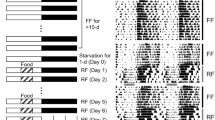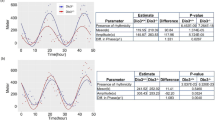Abstract
The circadian time-keeping system consists of clocks in the suprachiasmatic nucleus (SCN) and in peripheral organs including an adrenal clock linked to the rhythmic corticosteroid production by regulating steroidogenic acute regulatory protein (StAR). Clock cells contain an autonomous molecular oscillator based on a group of clock genes and their protein products. Mice lacking the VPAC2 receptor display disrupted circadian rhythm of physiology and behaviour, and therefore, we using real-time RT-PCR quantified (1) the mRNAs for the clock genes Per1 and Bmal1 in the adrenal gland and SCN, (2) the adrenal Star mRNA and (3) the serum corticosterone concentration both during a light/dark (L/D) cycle and at constant darkness in wild type (WT) and VPAC2 receptor-deficient mice (VPAC2-KO). We also examined if PER1 and StAR were co-localised in the adrenal steroidogenic cells. Per1 and Bmal1 mRNA showed a 24-h rhythmic expression in the adrenal of WT mice under L/D and dark conditions. During a L/D cycle, the adrenal clock gene rhythm in VPAC2-KO mice was phase-advanced by approximately 6 h compared to WT mice and became arrhythmic in constant darkness. A significant 24-h rhythmic variation in the adrenal Star mRNA expression and circulating corticosterone concentration was similarly phase-advanced during the L/D cycle. The loss of adrenal clock gene rhythm in the VPAC2 receptor knockout mice after transfer into constant darkness was accompanied by disappearance of rhythmicity in Star mRNA expression and serum corticosterone concentration. Double immunohistochemistry showed that the PER1 protein and StAR were co-localised in the same steroidogenic cells. Circulating corticosterone plays a role in the circadian timing system and the misaligned corticosterone rhythm in the VPAC2 receptor knockout mice could be involved in their abnormal rhythms of physiology.








Similar content being viewed by others
Abbreviations
- L/D:
-
12:12 h light/dark cycle
- WT:
-
Wild type
- Per1 :
-
Period1
- Bmal1 :
-
Brain and muscle ARNT-like protein 1
- RT-PCR:
-
Reverse trascriptase polymerase chain reaction
- VIP:
-
Vasoactive intestinal polypeptide
- VPAC2:
-
Vasoactive intestinal polypeptide receptor 2
- KO:
-
Knockout
- SCN:
-
Suprachiasmatic nucleus
- StAR:
-
Steroidogenic acute regulatory protein
References
Abrahamson EE, Moore RY (2001) Suprachiasmatic nucleus in the mouse: retinal innervation, intrinsic organization and efferent projections. Brain Res 916:172–191
Amir S, Lamont EW, Robinson B et al (2004) A circadian rhythm in the expression of PERIOD2 protein reveals a novel SCN-controlled oscillator in the oval nucleus of the bed nucleus of the stria terminalis. J Neurosci 24:781–790
Andrews RV (1980) Phase response profile of hamster adrenal organ cultures treated with ACTH and exogenous steroid. Comp Biochem Physiol 67:275–277
Asnicar MA, Koster A, Heiman ML et al (2002) Vasoactive intestinal polypeptide/pituitary adenylate cyclase-activating peptide receptor 2 deficiency in mice results in growth retardation and increased basal metabolic rate. Endocrinology 143:3994–4006
Aton SJ, Colwell CS, Harmar AJ et al (2005) Vasoactive intestinal polypeptide mediates circadian rhythmicity and synchrony in mammalian clock neurons. Nat Neurosci 8:476–483
Balsalobre A, Damiola F, Schibler U (1998) A serum shock induces circadian gene expression in mammalian tissue culture cells. Cell 93:929–937
Balsalobre A, Brown SA, Marcacci L et al (2000) Resetting of circadian time in peripheral tissues by glucocorticoid signaling. Science 289:2344–2347
Bechtold DA, Brown TM, Luckman SM et al (2008) Metabolic rhythm abnormalities in mice lacking VIP-VPAC2 signaling. Am J Physiol Regul Integr Comp Physiol 294:R344–R351
Berson DM (2003) Strange vision: ganglion cells as circadian photoreceptors. Trends Neurosci 26:314–320
Bittman EL, Doherty L, Huang L et al (2003) Period gene expression in mouse endocrine tissues. Am J Physiol Regul Integr Comp Physiol 285:R561–R569
Buckingham JC (2006) Glucocorticoids: exmplars of multi-tasking. Br J Pharmacol 147:S258–S268
Buhr ED, Yoo S-H, Takahashi JS (2010) Temperature as a universal resetting cue for mammalian circadian oscillators. Science 330:379–385
Buijs RM, Escobar C (2007) Corticosterone and activity: the long arms of the clock talk back. Endocrinology 148:5162–5164
Chrousos GP, Kino T (2007) Glucocorticoid action networks and complex psychiatric and/or somatic disorders. Stress 10:213–219
Colwell CS, Michel S, Itri J et al (2003) Disrupted circadian rhythms in VIP and PHI-deficient mice. Am J Physiol Regul Integr Comp Physiol 285:R939–R949
Dallman MF, Strack AM, Akana SF et al (1993) Feast and famine: critical role of glucocorticoids with insulin in daly energy flow. Front Neuroendocrinol 14:303–347
Dibner C, Schibler U, Albrecht U (2010) The mammalian circadian timing system: organization and coordination of central and peripheral clocks. Annu Rev Physiol 72:517–549
Dickmeis T (2009) Glucocorticoids and the circadian clock. J Endocrinol 200:3–22
Fahrenkrug J, Hannibal J (1998) Pituitary adenylate cyclase activating polypeptide immunoreactivity in capsaicin-sensitive nerve fibres supplying the rat urinary tract. Neuroscience 83:1261–1272
Fahrenkrug J, Hannibal J, Honoré B et al (2005) Altered calmodulin response to light in the suprachiasmatic nucleus of PAC1 receptor knockout mice revealed by proteomic analysis. J Mol Neurosci 25:251–258
Fahrenkrug J, Georg B, Hannibal J et al (2006) Diurnal rhythmicity of the clock genes Per 1 and Per 2 in the rat ovary. Endocrinology 147:3769–3776
Fahrenkrug J, Hannibal J, Georg B (2008) Diurnal rhythmicity of the canonical clock genes Per1, Per2 and Bmal1 in the rat adrenal gland is unaltered after hypophysectomy. J Neuroendocrinol 20:323–329
Georg B, Hannibal J, Fahrenkrug J (2010) Lack of the PAC1 receptor alters the circadian expression of VIP mRNA in the suprachiasmatic nucleus of mice. Brain Res 1135:52–57
Goetze JP, Georg B, Jørgensen HL et al (2010) Chamber-dependent circadian expression of cardiac natriuretic peptides. Regul Pept 160:140–145
Hannibal J, Fahrenkrug J (2002) Melanopsin: a novel photopigment involved in the photoentrainment of the brain's biological clock? Ann Med 34:401–407
Hannibal J, Fahrenkrug J (2004) Melanopsin containing retinal ganglion cells are light responsive from birth. Neuroreport 15:2317–2320
Hannibal J, Hsiung HM, Fahrenkrug J (2011) Temporal phasing of locomotor activity, heart rate rhythmicity, and core body temperature is disrupted in VIP receptor 2-deficient mice. Am J Physiol Regul Integr Comp Physiol 300:R519–R530
Harmar AJ, Marston HM, Shen S et al (2002) The VPAC(2) receptor is essential for circadian function in the mouse suprachiasmatic nuclei. Cell 109:497–508
Herbert J, Goddyer IM, Grossman AB et al (2006) Do corticosteroids damage the brain? J Neuroendocrinol 18:393–411
Hökfelt T, Lundberg JM, Schultzberg M et al (1981) Immunohistochemical evidence for a local VIP-ergic neuron system in the adrenal gland of the rat. Acta Physiol Scand 113:575–576
Holzwarth MA (1984) The distribution of vasoactive intestinal peptide in the rat adrenal cortex and medulla. J Autonom Nerv System 11:269–283
Hughes AT, Fahey B, Cutler DJ et al (2004) Aberrant gating of photic input to the suprachiasmatic circadian pacemaker of mice lacking the VPAC2 receptor. J Neurosci 24:3522–3526
Hughes ATL, Guilding C, Lennox L et al (2008) Live imaging of altered period1 expression in the suprachiasmatic nuclei of Vipr2 −/− mice. J Neurochem 106:1646–1657
Ishida A, Mutoh T, Ueyama T et al (2005) Light activates the adrenal gland: timing of gene expression and glucocorticoid release. Cell Metabolism 2:297–307
Kalamatianos T, Kallo I, Piggins HD et al (2004) Expression of VIP and/or PACAP receptor mRNA in peptide synthesizing cells within the suprachiasmatic nucleus of the rat and in its efferent target sites. J Comp Neurol 475:19–35
Lamont EW, Robinson B, Stewart J et al (2005) The central and basolateral nuclei of the amygdala exhibit opposite diurnal rhythms of expression of the clock protein Period2. Proc Natl Acad Sci USA 102:4180–4184
Lehoux JG, Lefebvre A (1980) De novo synthesis of corticosteroids in hamster adrenal glands. J Steroid Biochem 12:479–485
Loh DH, Abad C, Colwell CS et al (2008) Vasoactive intestinal peptide is critical for circadian regulation of glucocorticoids. Neuroendocrinology 88:246–255
Loh DH, Dragich JM, Kudo T et al (2011) Effects of vasoactive intestinal peptide genotype on circadian gene expression in the suprachiasmatic nucleus and peripheral organs. J Biol Rhythms 26:200–209
Maywood ES, Reddy AB, Wong GKY et al (2006) Synchronization and maintenance of timekeeping in suprachiasmatic circadian clock cells by neuropeptidergic signaling. Curr Biol 16:599–605
Meier AH (1976) Daily variation in concentration of plasma corticosteroid in hypophysectomized rats. Endocrinology 98:1475–1479
Nader N, Chrousos GP, Kino T (2010) Interactions of the circadian CLOCK system and the HPA axis. Trends Endocrinol Metab 21:277–286
Nelson W, Tong YL, Lee JK et al (1979) Methods for cosinor-rhythmometry. Chronobiologia 6:305–323
Nielsen HS, Hannibal J, Knudsen SM et al (2001) Pituitary adenylate cyclase activating polypeptide induces period 1 and period 2 gene expression in the rat suprachiasmatic nucleus during late night. Neuroscience 103:433–441
Oster H, Damerow S, Hut RAG et al (2006) Transcriptional profiling in the adrenal gland reveals circadian regulation of hormone biosynthesis genes and nucleosome assembly genes. J Biol Rhythms 21:350–361
Pollack SE, Furth EE, Kallen CB et al (1997) Localization of the steroidogenic acute regulatory protein in human tissues. J Clin Endocrinol Metab 82:4243–4251
Reppert SM, Weaver DR (2002) Coordination of circadian timing in mammals. Nature 418:935–941
Rhodes ME, Rubin RT (1999) Functional sex differences (‘sexual diergism’) of central nervous system cholinergic systems, vasopressin, and hypothalamic–pituitary–adrenal axis activity in mammals: a selective review. Brain Res Rev 30:135–152
Ronen-Fuhrmann T, Timberg R, King SR et al (1998) Spatio-temporal expression patterns of steroidogenic acute regulatory protein (StAR) during follicular development in the rat ovary. Endocrinology 139:303–315
SAS/STAT user's guide (1994) Cary, N.C.: SAS Institute, USA
Schroeder A, Loh DH, Jordan MC et al (2011) Circadian regulation of cardiovascular function: a role for vasoactive intestinal peptide. Am J Physiol Heart Circ Physiol 300:H241–H250
Sheward WJ, Maywood ES, French KL et al (2007) Entrainment to feeding but not to light: Circadian phenotype of VPAC2 receptor-null mice. J Neurosci 27:4351–4358
Son GH, Chung S, Choe HK et al (2008) Adrenal peripheral clock controls the autonomous circadian rhythm of glucocorticoid by causing rhythmic steroid production. Proc Natl Acad Sci USA 105:20970–20975
Son GH, Chung S, Kim K (2011) The adrenal peripheral clock: glucocorticoid and the circadian timing system. Front Neuroendocrinol 32:451–465
Storch KF, Lipan O, Leykin I et al (2002) Extensive and divergent circadian gene expression in liver and heart. Nature 417:78–83
Thompson WE, Powell J, Thomas KH et al (1999) Immunolocalization and expression of the steroidogenic acute regulatory protein during the transitional stages of rat follicular differentiation. J Histochem Cytochem 47:769–776
Torres-Farfan C, Serón-Ferré M, Dinet V et al (2006) Immunocytochemical demonstration of day/night changes of clock gene protein levels in the murine adrenal gland: differences between melatonin-proficient (C3H) and melatonin-deficient (C57BL) mice. J Pineal Res 40:64–70
Usdin TB, Bonner TI, Mezey E (1994) Two receptors for vasoactive intestinal polypeptide with similar specificity and complementary distributions. Endocrinology 135:2662–2680
Vosko AM, Schroeder A, Loh DH et al (2007) Vasoactive intestinal peptide and the mammalian circadian system. Gen Comp Endocrinol 152:165–175
Zvonic S, Ptitsyn AA, Conrad SA et al (2006) Characterization of peripheral circadian clocks in adipose tissues. Diabetes 55:962–970
Acknowledgments
The skilful technical assistance of Anita Hansen, Yvonne Søndergaard and Tina Wintersø is gratefully acknowledged. The study was supported by the Danish Biotechnology Center for Cellular Communication.
Conflict of interest
The authors have nothing to disclose.
Author information
Authors and Affiliations
Corresponding author
Rights and permissions
About this article
Cite this article
Fahrenkrug, J., Georg, B., Hannibal, J. et al. Altered Rhythm of Adrenal Clock Genes, StAR and Serum Corticosterone in VIP Receptor 2-Deficient Mice. J Mol Neurosci 48, 584–596 (2012). https://doi.org/10.1007/s12031-012-9804-7
Received:
Accepted:
Published:
Issue Date:
DOI: https://doi.org/10.1007/s12031-012-9804-7




